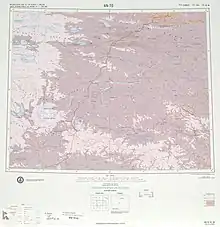Tongtian River
The Zhi Qu (Tibetan) or Tongtian River (Chinese: 通天河; pinyin: Tōngtiān Hé), flows within Qinghai Province of southern China. It is within the Yangtze River Basin—Chang Jiang drainage basin.

Geography
The three principal headwaters—the Chumaer, Muluwusu, and Akedamu rivers—join to form the Tongtian River, which flows southeast to Zhimenda near the frontier between Qinghai and Sichuan provinces, where it becomes the Jinsha River (Jinsha Jiang).
The Jinsha River is a primary and westernmost tributary of the Yangtze River (Chang Jiang).
The Tongtian River is one of the five large rivers flowing from headwaters on the Qinghai-Tibet Plateau.[1] Its length is 813 kilometres, draining an area of 138,000 square kilometres. Pilgrims go to the river because it is mythical, but also it is known for its "sutra bridge" and "Gyiana Mani stones".[2]
Dams
The Tongtian is planned for heavy development, primarily for hydroelectric power. As of March 2014 a total of 10 dams are planned for the river. Those dams are listed below from downstream to upstream.[3][4]
- Sewu Dam – Planned, 176.8 MW
- Xirong Dam – Planned, 160.5 MW
- Cefang Dam – Planned, 158 MW
- Genzhe Dam – Planned, 612 MW
- Leyi Dam – Planned, 112.8 MW
- Dequkou Dam – Planned, 276.5 MW
- Ruoqin Dam – Planned, 200 MW
- Lumari Dam – Planned, 72 MW
- Yage Dam – Planned, 63.6 MW
- Marigei Dam – Planned, 10.4 MW
See also
- Index: Tributaries of the Yangtze River
- List of rivers in China
References
- Baying Dongzhub Cerang (4 September 2004). "River discharge changes in the Qinghai-Tibet Plateau". Retrieved 2007-12-02.
- "The Tongtian River, a mythical tributary". China Daily. Retrieved 2007-12-02.
- Dong, Luan. "INTERACTIVE: Mapping China's "Dam Rush"". Wilson Center. Retrieved 15 June 2014.
- "The Last Report on China's Rivers". China's Rivers Report. March 2014. Retrieved 15 June 2014.